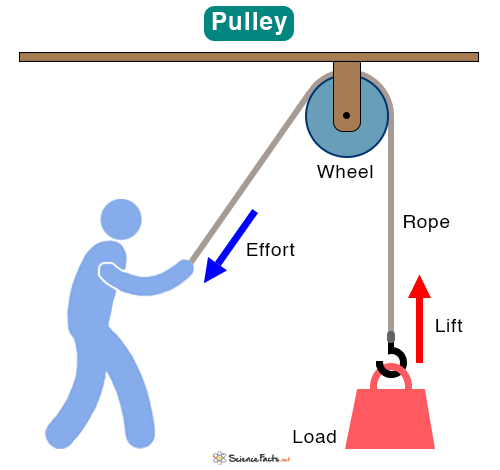Pulley
What is a Pulley
A pulley is a simple machine consisting of a wheel rotating about its axle. It is constructed by looping a rope or a cable around the groove of the wheel. Therefore, the three main parts of a pulley are the wheel, axle, and rope. A pulley is used for lifting heavy objects by applying force at one end of the rope.
The Greek mathematician and physicist Archimedes is credited to have invented the pulley in the 3rd century B.C.
How Does a Pulley Work
A pulley works by changing the direction of the applied force that is manifested at the object. The wheel rotates about its axle when the rope is pulled from one end and the object is raised above the ground. The other end is either fixed or attached to the object. The groove in the wheel helps to keep the rope in place. Combining two or more pulleys increases the number of loops and reduces the effort required to lift the object. However, the work done will still depend on the mass and the height raised.
Mechanical Advantage of a Pulley
The mechanical advantage of a pulley is a measure of the effectiveness of the pulley. It calculates how much the applied force multiplies to lift an object effectively. The formula for ideal mechanical advantage (IMA) is given by the ratio of the load to the effort. It is proportional to the number of loops of the rope. A higher mechanical advantage requires low force, but the distance traversed by the rope is greater.
Types of Pulley
Depending upon how the rope and the wheel are combined, there are three types of pulleys.
1. Fixed Pulley
Also known as a single pulley, it is the simplest of all pulleys. The pulley is fixed to one spot, and the wheel rotates about its axle. The rope moves over the wheel, pulling the load. The effort required to lift the object is the same as its weight. Hence, the mechanical advantage is equal to 1.
Examples: Pulleys used in flag poles, window blinds & curtains, clotheslines, and water wells
2. Movable Pulley
It is slightly complex than the fixed pulley. The pulley does not remain fixed. It is attached to the load, and the two move together. The disadvantage is that the pulley itself adds to the weight of the load. This pulley is suitable when the load is below the person lifting them.
Example: Pulley used in a zip line
3. Compound Pulley
It combines fixed and moveable pulleys. The advantage of this system of pulleys is that the effort required to move a load is less than half the load. The more the number of pulleys, the less is the effort. The mechanical advantage is always greater than 2. However, the disadvantage of using a compound system is that the length of the rope and the distance it travels increase. It means that a longer time is required to lift the load. A system of two pulleys is called a double pulley.
Example: Block and tackle and pulleys used in construction cranes, modern elevators, and exercise equipments
Uses and Applications of Pulley
- A flagpole uses pulleys to hoist a flag in schools
- A clothesline in a house uses pulleys to pull clothes towards the user
- An elevator uses pulleys to lift people
- A cargo lift system hoists objects to a higher level using pulleys
- A well uses a single fixed pulley to lift a bucket of water
- Exercise equipment uses a pulley to lift weights
- A crane consists of a pulley system that lifts and moves heavy equipment
- A theatre uses a system of pulleys to lift curtains
- A window blind uses pulleys to open and raise
- A sailboat uses pulleys to raise sails
The above image shows examples of pulleys that are used in everyday life.
-
References
Article was last reviewed on Tuesday, January 18, 2022












thanks for help i was so confused
bye until next time sarah
very informational
Looking for a diagram showing components of wooden pulleys, Breech, thimble sheave, cheek, and what is a swallow?
I’m working on Digital Twin matters and updating a related technical report, “Characterization of Digital Twin”, https://www.researchgate.net/publication/353930234_Characterization_of_Digital_Twin
I’m going to include a development case of Digital Twin using your pulley system figure, titled “Senior Strength Training Equipment Digital Twin.” The figure will be a little updated for status sensing and wheel braking.
Could you permit your figure to be used in our technical report?
Sure. Please cite our site.
Examples of compound pulleys with the rope at any other angle than normal to the ground are just plain wrong. One such example is a system with a moveable pulley attached to the weight and an overhead fixed point and an overhead fixed lifting pulley (that the rope is pulled down from reversing the path at the ceiling). Once the angle moves away from 90, the mechanical advantage starts decaying until at 30 degrees where it starts to take MORE effort to raise the load than the weight itself. BUT, example after example show angled ropes with compound pulleys with WRONG explanations. Again, keep the examples normal to the ground and they’d be correct. Separate pulleys, or complex systems of pulleys by horizontal distance and all the answers are wrong unless you know sin and cos functions and the angle and allow calculations to be completed. Thanks! PS This problem is all over the internet in mechanical aptitude assessements.